|
|
At Sage Hen Farm in Lodi, NY, we have planted many varieties of potatoes over the years, with the numbers and varieties changing each year, but these are varieties we have planted in recent years. Please note: we sell potatoes locally only (Ithaca, Trumansburg, and Lodi, NY), and, as we are not certified, we do not sell seed potatoes. Fingerling | Red & Rose | Blue/Purple | Yellow-fleshed | White-fleshed, including Russet |
|
|
|||||||||||||||||||||||||||||||||||||||||||||||||||||||||||||||||
| Fingerling | ||||
|---|---|---|---|---|
| Variety Origin |
Color:
Skin & Flesh Shape |
Starch Harvest | Yield |
Disease Resistance |
Images Special Notes |
|
Amarosa |
deep red skin; pink flesh with red streaks long |
low mid to late average |
High resistance to late blight and scab. |  Rich, creamy flavor. They retain their color even as they are baked or fried, so when sliced, they can look like a pepperoni. |
| Austrian Crescent (Kipfel) Austria/Germany before 1850 |
yellow tan skin; light yellow flesh crescent |
low mid to late high |
Low resistance to late blight and scab. |
 Noted for rich flavor. Grows quite close to the surface, so hill well to prevent greening in sunlight. |
| French (Roseval, Nosebag) France introduced 1950 |
dark rose-red skin; yellow flesh with red
streaks rounder than other fingerlings |
low mid to late average |
Moderate resistance to scab. | Noted for rich flavor. According to an old story, French fingerlings were smuggled into North America in a horse's nosebag. |
| Ozette (Anna Cheeka's, Makah Ozette) Washington State introduced in 1987 |
yellow tan skin with speckles; creamy white
flesh oblong to long |
medium early to late low |
High resistance to late blight. |  Noted for earthy flavor. Discovered on the Olympic Peninsula. Speculation is that the first Ozettes were brought there by Spanish explorers from Peru before 1600. |
| La Ratte (Corne de Mouton, Ram's Horn, Princess La Ratte) France or Denmark before 1875 |
yellow tan skin; yellow flesh crescent |
low mid to late high |
Good resistance to scab. |

Skin darkens from light yellow to a golden yellow in storage. Flavor has been called nutty, earthily sweet, buttery, and also likened to mushrooms. |
| Papa Cacho Peru introduced to North America in 1998 |
dark rose-red skin; white and pink flesh longer, curvier than other fingerlings |
low late average |
Good resistance to scab, high resistance to late blight foliage. | A locally grown variety in one part of Peru. Once discovered, it took many years before it could be exported out of the country.. |
| Rose Finn (Rose Finn Apple, Pink Fir Apple, Rosa Tannenzapfen) Germany before 1850 |
light brown skin with pinkish mottling;
yellow-gold flesh long, knobbly, with nodes |
low mid to late average |
High resistance to scab. Vwery low resistance to late blight foliage. |  Noted for very rich flavor. "Finn Apple" appears to be a corrupted translation of fir-cone, which is somewhat resembles. It has a loyal following, despite or because of its knobbly shape. |
|
See also Magic Molly in Blue/Purple. Did you know? The name "fingerling" was used because the size and shape of the potatoes resembled the small, young fish used by hatcheries for stocking ponds and streams, which in term were called fingerlings because of their resemblance to fingers. Because of fingerlings shape and size, they can be extra work in
preparing, but their extra flavor and firm texture make them a
first choice for roasting. They cook well when steamed or boiled,
so they are also excellent for making potato salad. |
||||
| Red & Rose |
||||
|---|---|---|---|---|
| Variety Origin |
Color:
Skin & Flesh Shape |
Starch Harvest | Yield |
Disease Resistance |
Images Special Notes |
| Adirondack Red (was T17-2) New York introduced 2004 |
purplish red skin; pinkish red flesh oblong |
low early to mid medium high |
Moderate resistance to
common scab and golden nemotode. |
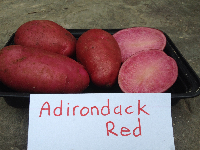 Developed at Cornell for its red flesh. Keeps color after cooking; turns pink when mashed. |
| Dark Red Norland Nebraska introduced 1967 |
dark red skin; white
flesh round to oval |
low early high |
Moderate resistance to common scab and late blight. |  Noted for rich flavor for an early potato. Good producer of medium to large tubers. Developed from the Norland for better color. |
| Desiree Netherlands introduced 1952 |
pink to reddish skin with dark spots; light
yellow flesh oval to oblong |
medium high mid high |
Moderate resistance to late blight and common scab. | 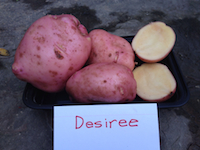 Noted for a special "gourmet" flavor. The most widely grown red potato in Europe. |
| Kerr's Pink Scotland introduced 1907 |
light brown skin, with pink highlights; creamy
white flesh flat oval |
high mid high |
Low resistance to late blight. Good resistance to common scab. |
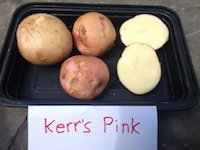 Noted for very rich flavor. Grown widely throughout the British Isles; second most widely grown variety in Ireland. |
| Red Gold (Red River Gold) Ontario introduced 1987 |
pinkish red skin; yellow flesh round to oval |
medium early high |
Moderate resistance to common scab. Somewhat blight resistant. | 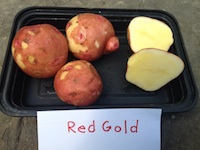 Noted for rich flavor. Produces lots of small to medium tubers. |
| Red Maria (was NY 129) New York introduced 2011 |
bright, deep red skin; white flesh round |
medium late high |
High resistance to common scab and golden
nemotode. |
 Developed at Cornell for blight resistance, high yield and uniformity of shape and size. |
| Romanz (Romanze) Germany introduced 1973 |
red skin; yellow flesh oval to long |
medium late average |
High resistance to late blight |  Noted for rich flavor. Developed for its brillant red skin and brillant yellow flesh. The brillance, however, is variable. Our original supplier no longer sells this variety, so we've been trying to keep Romanze going on our own. |
| Strawberry Paw (was NY 136) New York introduced 2013 |
dark red skin; white flesh oval to long |
medium late average |
High resistance to late blight | 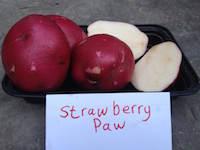 Developed at Cornell for blight and scab resistance. Has an exceptionally dark red skin. |
|
See also French in Fingerling
|
||||
| Blue/Purple | |||||
|---|---|---|---|---|---|
| Variety Origin |
Color:
Skin & Flesh Shape |
Starch Harvest | Yield |
Disease Resistance |
Images Special Notes |
|
| Magic Molly Alaska introduced 2012 |
deep purple skin; deep purple flesh oblong |
medium late low |
Vigorous, but resistance to most diseases unknown. |  Developed in Alaska in the race for the deepest blue flesh and for a purple potato that keeps its color when boiled. Tuber size varies. Considered a fingerling by some. |
|
| Purple Majesty Colorado introduced 2005 |
purple skin; purple flesh oblong |
medium mid average |
Good resistance to late blight; high resistance to common scab. |
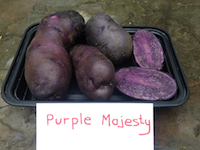 Developed in Colorado State in the race for the deepest blue flesh. |
|
| Purple Sun (Peter Wilcox, Blue Gold) Maryland introduced 2007 |
purple skin; yellow flesh round to oblong |
medium mid low |
Low resistance to late blight; good resistance to common scab. |
 Developed for its beautifully textured deep purple skin over golden flesh. It was originally named for a professor of religion at Loyola University in Baltimore. |
|
| Purple Viking North Dakota after 1963 |
splotchy purple over pink skin; white flesh round to oblong |
medium high mid high |
Low resistance to late blight; high resistance to
common scab. |

Sport of the Viking, a red skin potato, which was developed in 1963. Known for producing only an average size crop, but the tubers can be enormous. |
|
| See also Purple Peruvian in Fingerling Did you know? The purple/blue color comes from polyphenols, specifically the anthocyanins, the same flavonoid that gives blueberries their color and gives both the same powerful antioxidant property. As a group, blue potatoes fit right in the middle between moist and dry, which puts them square in middle of the all-purpose category. Their color and bolder earthy flavor, however, make for special challenges or an opportunities. Some folks think blue mashed potatoes are the coolest thing, but others might not find them appealing at all. They stand up well with foods with fuller flavor and extra seasoning. Many folks like to use them in combination with red and white potatoes, for a more colorful presentation. |
|||||
| Yellow-fleshed | ||||
|---|---|---|---|---|
| Variety Origin |
Color:
Skin & Flesh Shape |
Starch Harvest | Yield |
Disease Resistance |
Images Special Notes |
| Anuschka Germany introduced 2004 |
smooth yellow tan skin; rich yellow flesh oval |
medium to large |
Good resistance to late blight and scab. |
 Developed for disease resistance, but has a rich flavor. Good in salads, but versatile enough for most other uses. |
| Bintje Netherlands introduced 1910, thought to have been introduced to the US by returning WWI soldiers |
yellow tan skin; creamy yellow flesh oval |
medium |
Low resistance to late blight tubers and foliage. Low resistance to scab. | Noted for rich flavor, and became THE potato for French fries in Europe (where they are called pomme frites), but because of high moisture but low starch, very versatile. |
| Carola Germany introduced 1979 |
yellow tan skin; light yellow flesh oblong |
medium mid higher than average |
Moderate resistance to late blight tubers; low resistance to late blight foliage; high resistance to scab. | 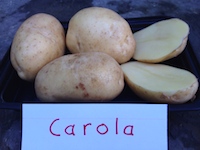 Noted for its buttery flavor. It was more widely popular commercially before the introduction of the Yukon Gold (which has a higher yield, not necessarily a better flavor or versatility). It is still popular in many parts of Europe, and it one of our favorites. Keeps well. We've eaten potatoes from previous year's crop after we've started to harvest a new crop. Grows quite close to the surface, so hill well to prevent greening. |
| German Butterball US mid 20th century |
rough yellow tan skin; bright or dark yellow flesh oval to oblong (not round as the name might suggest) |
medium high late high |
Moderately good resistance to late blight. Good resistance to scab. |  Gained attention after it won the title best flavored potato in a Rodale test taste in the 1980s. The use of the word "German" in the name may come from the fact that it was yellow fleshed, which was common for poatoes in Europe, but rare in North America. Its origin is hard to trace earlier than the 1980s. Tubers are variable in size, but mostly medium. |
| Yellow Finn Finland, via Washington State 1950s |
yellowy skin, light to dark yellow flesh round to pear-shaped, occasionally flattened |
medium mid average |
Good resistance to scab. | 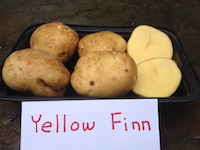 Noted for rich flavor. Credit for the introduction of this variety is given to Carl Gustav Riipinen, a potato farmer from Washington State, who said he brought them from Finland in the 1950s. Only widely grown this century. Expect a high percentage of small tubers. |
|
Note: Austrian Crescent and Rose Finn in Fingerling,
and Desiree, Red Gold & Romanz in Red
& Rose also have yellow flesh. Did you know? The yellow flesh color comes from beta-carotene, lutein, and zeaxanthin, the same carotenoids that give egg yolks and corn their color and give them all the same powerful antioxidant property. Yellows are potatoes with various shades of yellow flesh, from
almost creamy white to almost the color of an egg yolk. The extra
color translates to being more nutritious and more flavorful than
most white fleshed potatoes. Perhaps it is the power of
suggestion, but "buttery" seems a common description for their
taste. Carola and German Butterball have regularly won taste tests
we have held in recent years. |
||||
| White-fleshed,
including Russet |
||||
|---|---|---|---|---|
| Variety Origin |
Color:
Skin & Flesh Shape |
Starch Harvest | Yield |
Disease Resistance |
Images
(or Links to Images) Special Notes |
| Algonquin New York introduced 2017 |
yellowy skin, creamy white flesh oval |
low early to mid average |
High resistance to scab. |

Developed at Cornell as an early, highly productive, blemish-free potato of good size. It has good flavor, too. Doesn't fall apart when boiled. |
| Caribou Russet Maine introduced 2015 |
light russet skin; very white flesh long oblong |
hgh excellent |
High resistance to hollow heart, rot, and scab. |
 Developed in Maine to compete in russet potato market. Is high-yielding with great flavor and disease resistance. |
| Gold Rush (Goldrush) North Dakota introduced 1992 |
light russet skin; very white flesh oblong |
hgh excellent |
Low resistance to early and late blight, and rot.
High resistance to hollow heart and scab. |
 Developed to improve on the Russet Burbank, especially in higher yield and better resistance to hollow heart . |
| Early Ohio Vermont introduced 1871 |
light tan, with occasional pink patches; white
flesh round |
medium high early average |
Moderately resistance to late blight, common scab | Not from Ohio. It has been credited with being the first potato grown specifically for baking, but it is not an especially starchy potato. We think it the most flavorful of white-fleshed potatoes. |
| Kennebec Maine introduced 1948 |
light tan; white flesh oblong |
medium high mid high |
Moderately resistance to late blight. Low resistance to common scab. | Known for its papery skin. Spuds can grow very large. Once the most used potato for potato chips, but replaced by better storing potatoes with more uniform size. |
|
See also Ozette in Fingerling ue to their high starch content, are the first choice for baked
potatoes. |
||||
| Notes |
|---|
Flavor:
Harvest:
Yield:
Storage: Some sources list the storage qualities of the different potato varieties, but in general, early varieties do not store as well as late varieties. A related factor is dormancy, meaning how likely the spuds are likely to sprout during storage. Only varieties with exceptional poor dormancy (most likely to sprout) are noted above. Disease resistance levels:
Photo of the giant potato by Paul Ievins. URL: http://www.sagehenfarmlodi.com/potato.html |